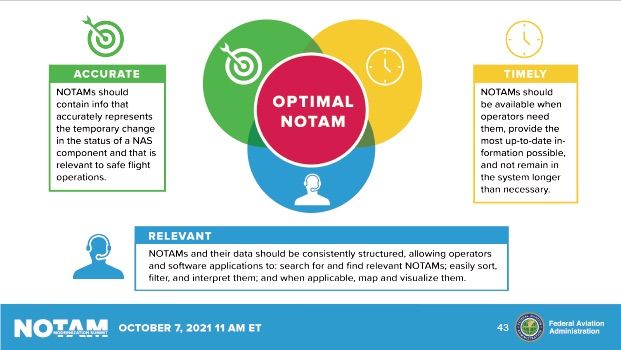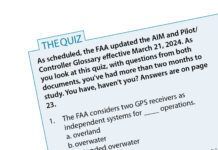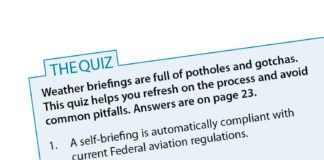Air Canada Flight 759 almost landed at night on a taxiway adjacent to closed SFO Runway 28L on July 7, 2017. At the last moment, the pilots aborted. The NTSB estimated it came within 14 feet of another aircraft.
Investigators discovered the NOTAM closing the runway was buried on page 8 of their 27-page flight release. In late 2018, then-NTSB Board Chairman Robert Sumwalt complained NOTAMs were too confusing to be useful because “they’re written in language only a computer programmer would understand.” NOTAMs were, in his words, “just a bunch of garbage that nobody pays any attention to.”
It’s improving. Today’s Federal NOTAM Search (FNS) website supports plain-language. In May 2018, Leidos’s Flight Service website replaced text-based DUATS four months before Sumwalt’s stinging condemnation.
Yet the U.S. NOTAM System (USNS) remains as of old, with its cryptic abbreviations, abstract keywords and shorthand, and irrelevant, illogically ordered lines. The ancient Aeronautical Fixed Telecommunications Network is limited to upper case and free text, neither of which works once we seek to share data digitally across systems. All told, it’s a dusty back office full of legacy hardware and software.
USNS produces over 1.3 million NOTAMs a year—way too many. The FAA says we get seventy pages of NOTAMs per brief, with critical safety data buried within. Incompatible with ICAO Aeronautical Information Standards, U.S. NOTAMs cannot link seamlessly with ICAO Air Navigation Service Providers like Canada.
Driven by the FAA Reauthorization Act of 2018 requirement to provide a single authoritative source for NOTAMs, the FAA added the NOTAM Modernization Initiative to its task basket in 2019, promising foundational improvements to the NOTAM system, which had long suffered from benign neglect.
Achievements to Date
Shakeups like this have a predictable genesis: reorganize and rename. The FAA consolidated its aeronautical information resources into one new single-point-of-contact directorate, Aeronautical Information Services, at www.faa.gov/air_traffic/flight_info/aeronav/. AIS is the sole authoritative steward of all aeronautical information, including NOTAMs, schedules, preferred routes, TFRs, SUA, obstacle, and navaid data.
AIS is part of the Air Traffic Organization, which includes ATC. It’s no coincidence that Aeronautical Information Services shares its name with ICAO Annex 15’s title. The message is plain: “ICAO Welcome Here.”
Within AIS, the U.S. NOTAM Office performs quality control, assures compliance with NOTAM policy, and disseminates NOTAMs, especially time-critical ones, to the National Airspace System (NAS.) It doesn’t issue NOTAMs; these come from airports, Flight Service, ATC, and elsewhere.
The U.S. NOTAM Governance Team is the authoritative source for U.S. NOTAM policy and maintains FAA Order 7930.2, Notices to Air Services, which sets policy for NOTAM operations in the NAS. Rigor is the name of the game.
Consistent with the single-point-of-contact principle, the FAA sunsetted NTAP (Notices to Airmen Publication), and PilotWeb. NOTAM Search is the only official online NOTAM resource at notams.aim.faa.gov/notamSearch. Your EFB is legal since it gets its data from the same AIS source.
Erroneous routes prompt updates from FAA’s ERAM routing computer, compelling pilots to rework their flight plans. In 2018, the FAA pruned Preferred and Coded Departure Route information from three sources down to one authoritative source, solving a problem where a route from one source might conflict with another’s. They also modified 5827 preferred routes and installed processes to prevent future errors.
Formerly updated by hand, an error-prone process, Chart Supplements are now automated. Pressing one button publishes consistent data across multiple sources. The FAA also removed duplicative information.
Works In Progress
Partially ICAO-formatted NOTAMs are likely available on NOTAM Search by the time you read this for the approximately 70 percent of digitally-formatted NOTAMs. This exposure helps familiarize us with the ICAO format, but only the current domestic FAA NOTAM format is official for now.
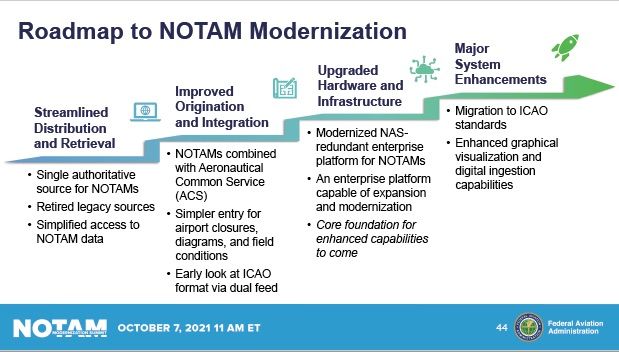
In August 2023, cutover from the USNS to the FNS will be completed. FNS offers enhanced reliability and robust outage resistance. Failure of FNS can bring down a sizable chunk of the NAS, so FNS service continuity is crucial.
With the FNS platform in place, the full-blown ICAO format will become official in December 2024. The ICAO format offers many benefits. Let’s take a look.
Reducing NOTAMS
The FAA is reducing the excessive number of permanent NOTAMs (PERM NOTAMs), which once born often became immortal. About 75 percent have been removed to date. To prevent a recurrence, the FAA improved the management and cancellation of PERMs, reducing their number also by 75 percent.
It helps to get PERM NOTAMs into print as soon as possible. This is why Sectional, VFR Terminal Area, and VFR Flyway Planning charts are now published in 56-day cycles, consistent with other aeronautical publications. Since current information is added more frequently, PERM notices can be canceled sooner.
Duplicates can occur when a procedure is NOTAMed not available, yet a more recent NOTAM raises the minimums for the same procedure, causing NOTAM “noise.” Given the 80,000 NOTAMs they process monthly, AIS sometimes misses errors like this.
Two NOTAMs might be identical except for timeframe. For example, one crane arrives, then another, operating at separate times. It would make sense to consolidate them, but again, for now it’s a human failure despite a rigorous process.
Airport NOTAMs
About 80 percent of all NOTAMs originate from airport operators. Some write better ones than others. Operators should ask, “Is this understandable? Is this helping pilots?” One recent goof specified a contingent frequency and later cited a different one. Uhhh…
The search system is only as good as the quality of the NOTAM. By the end of 2022, airport operators will have an updated Advisory Circular 150-5200-28, which tells how to dispose of permanent, fuel condition, and wildlife NOTAMs. An updated NOTAM Order 7930.2 will spell out more clearly when a NOTAM is required. A recent NASA study looked at the accuracy of NOTAMs, how they wound up in different categories and buckets, and how they were confusing, misleading, or wrong. The FAA is consulting NASA for further guidance.
Part of the solution leverages automation. The FAA offers NOTAM Manager, a free website that helps airports produce quality, compliant NOTAMs. The FAA is promoting NOTAM Manager for smaller, less frequented GA airports so we can access the same easy visualization tools that pilots get at larger airports. Hopefully, your airport uses it.
Field Condition Notices comprise about 73 percent of all NOTAMs. A new FICON enhancement halves the need to issue two FICONs—one per runway end of the same asphalt—into one FICON when conditions are the same. Software will prevent publishing a FICON if the runway is closed.
Airport authorities sometimes use NOTAMs to shield themselves from liability, in an abundance of caution, or simply due diligence. NOTAMs for non-movement areas are one example. A wildlife biologist who works with airports finds PERM Wildlife NOTAMs uninformative. Former NTSB chairperson Robert Sumwalt agreed: “…pages and pages of NOTAMs including Birds INVOF Airport. [When are] birds ever not in the vicinity of an airport?”
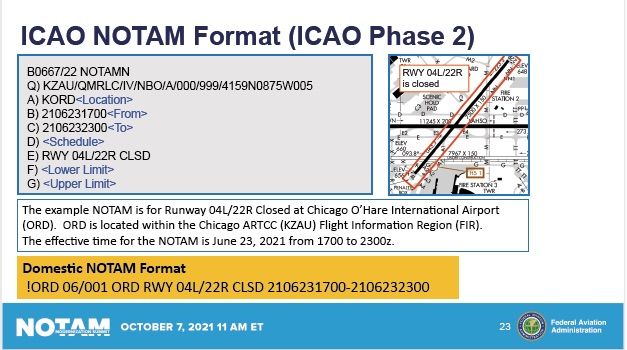
Especially at Part 139-certified airports, if a work order to fix something is issued, FAA inspectors expect a NOTAM to be issued, even if the pilot doesn’t need to know. Regulations sometimes require NOTAMs. One solution could be to display runway and taxiway closures first, followed by less relevant issues. ICAO format offers coding that makes filtering and sorting easy.
ICAO format can affect airport operators more than pilots because categorizing the Qualifier or Q-code line is vital. The Qualifier contains coded information, coordinates, and radius for areas that allow automated NOTAM filtering, formatting, series, and numbering.
Automation will help determine and check the Q-code. An outreach training program will be necessary to teach airport operators to map Q-codes correctly so prioritization can work properly. Yes, ICAO supports non-ICAO airport alphanumeric codes.
ICAO
Rooted in the 1920s, the U.S. NOTAM system cannot support modern information technology. For instance, 30 percent of NOTAMs are not machine-readable. ICAO’s NOTAM standard takes full advantage of I.T. to search, sort, and filter only NOTAMs we care about and even swap text for graphics. The rich ICAO format can produce pictures, charts, fewer but more readable words, and give us accurate, timely, available, relevant information. And ICAO NOTAMs are archived for future reference.
Of ICAO’s 23 sort-by capabilities, thirteen are planned for civil use. ICAO replaces less-defined FAA keywords with series letters. For example, Series letter V means a NOTAM regarding published instrument procedures. The FAA regards the U.S. military—which uses six separate series letters—as a separate ICAO state since they use only the ICAO format.
The contextuality in an ICAO NOTAM permits tailoring it to the type of aircraft, procedure, operation, and what the issuer is trying to accomplish. The magic is in the Q-code line. The FAA picks the subset of codes we need and builds them into the new ICAO system. Human error is reduced by including only the codes we need.
Plain text and free text aren’t the same, except both add pages. Plain text converts defined abbreviations, contractions, and acronyms into readable language. They’re less ambiguous than free text, but there is no abbreviation standard today, although an ICAO working group is looking at it. MFD’s will likely continue using abbreviations. Sorry, there’s no ICAO decoder ring.
Free text will always be necessary; established conventions cannot address all possible situations. This opens the door to synonyms and ambiguity, either of which can turn a NOTAM into a hazard.
There are potential incompatibilities with other ICAO states because their automation may limit how much free text they can support, among many other potential disparities. ICAO-compliant states are anchored to ones with lesser capability unless they just shoot for the majority.
Total standardization is unreachable with 193 member states, but global harmonization is. ICAO recognizes differences filed by member states, and the FAA has taken many. Our partially ICAO-compliant Aeronautical Information Publication contains 95 pages of differences, and JO 7000.6B states differences for ATC. Incidentally, the newish U.S. NOTAM definition is now Notice to Air Missions. Ironically, this too differs from ICAO format.
ICAO is imperfect. Rules are not always straightforward, are sometimes subjective, and even too flexible. Compromises must still be made.
Differences in aviation often have bad results. Standard procedures and methodology help ensure success. Beyond the substantial direct benefits, eliminating disparities reduces risk and is a key motivator to harmonize with ICAO standards.
Electronic Flight Bags
In a recent AOPA study, 71 percent of members use EFBs to check NOTAMs before flight. About 19 percent use the FSS and FAA’s NOTAM pages. That adds up to around 90 percent of how pilots check NOTAMs. Unsurprisingly, 88 percent prefer the decoded flavor.
One unpleasant surprise is that over 80 percent find it difficult to assess the impact of a NOTAM. About a third said they have trouble understanding even decoded NOTAMs, much less their impact. This reinforces the need to write NOTAMs logically and understandably. Cognitive studies may help resolve this thorny issue.
EFB vendors brilliantly prioritize the most important NOTAMs first, such as runway closures. Developers and the FAA see graphics as a great way to digest information, especially in the terminal area. If you see a runway or taxiway symbol, there’s a runway or taxiway NOTAM. Graphics help us find what we need and minimize words and pages. To this end, the ICAO Q-line offers much information that helps classify and individualize NOTAMs, such as filtering for IFR NOTAMs.
Flight Service
Flight Service is unique in that it both originates and consumes NOTAMs. Many briefers say the most challenging part of delivering a weather briefing is sifting through pages of NOTAMs for the pertinent ones. Prioritization will be simpler once ICAO is implemented. Until then, FSS is working to reduce the volume of airport NOTAMs.
You Can Help
Data is only as useful as our ability to turn it into actionable information. An optimal NOTAM is easy to find, relevant, timely, accurate, unambiguous, and concise.
The FAA knows they cannot always understand how the quality issue affects us or how to do the job better. Use the Aeronautical Inquiry portal to give them feedback to improve the system. Don’t be shy. Speak up!
Fred Simonds, CFII, thanks the dedicated FAA experts who cheerfully contributed to this article. They exemplify the best of civil servants. There is abundant internal motivation to make progress on this project.

